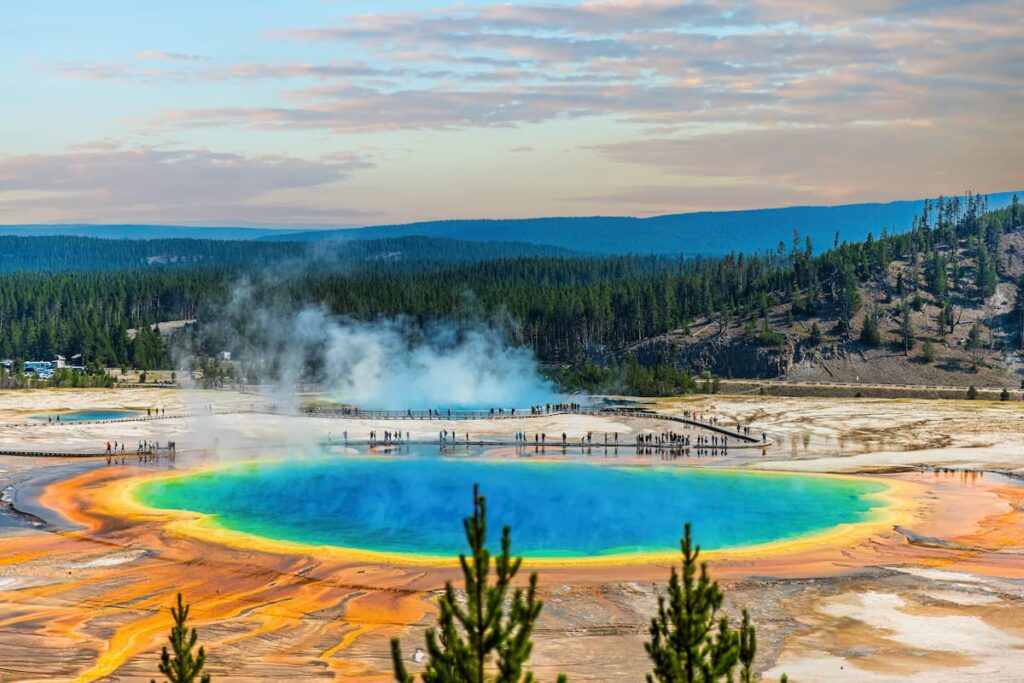A Hidden Shield Beneath Yellowstone
Yellowstone National Park, known for its stunning geothermal wonders, sits atop one of the largest active volcanic systems in the world. For years, scientists have known about the presence of magma beneath its surface, but much of its internal structure remained a mystery. Now, a team of researchers from Rice University, the University of New Mexico, the University of Utah, and the University of Texas at Dallas has made a significant discovery that sheds new light on the park’s volcanic stability.
The scientists found a massive magma cap located approximately 2.4 miles beneath Yellowstone. Acting like a natural lid, this molten cap traps heat and pressure, playing a crucial role in keeping the volcanic system stable. The discovery was made possible through the use of high-resolution seismic imaging and advanced computer modeling, which allowed researchers to visualize Yellowstone’s inner structure in unprecedented detail.
The team confirmed that the magma system has been dynamic for millions of years, with the upper boundary of the magma reservoir now clearly defined. This breakthrough answers long-standing questions about the depth and structure of Yellowstone’s underground world, offering new hope for predicting future volcanic behavior.
Unlocking Yellowstone’s Inner Workings
Using a powerful vibroseis truck that injected low-frequency vibrations into the ground, the researchers created miniature seismic events to map the subsurface layers. Through these methods, they detected that the magma cap consists of silicate melt and supercritical water bubbles enclosed within a network of porous rock.
This unique combination of materials allows the magma cap to act as a natural barrier, influencing the overall stability of the volcanic system. The cap appears to be actively releasing gas while maintaining a steady state, a sign that Yellowstone’s underground system is both alive and remarkably balanced.
The findings suggest that the behavior of the magma reservoir is critical to understanding Yellowstone’s long-term volcanic activity. With this detailed view of the cap’s structure and its volatile components, scientists now have a stronger foundation for monitoring any future changes.
A Natural Pressure-Release System
One of the biggest concerns when studying volcanoes is the accumulation of gases like water vapor and carbon dioxide. Under certain conditions, these gases can separate from magma, form bubbles, and potentially lead to explosive eruptions. However, Yellowstone’s system currently shows a much less threatening pattern.
The magma cap appears to be efficiently venting gases through the porous rock in a process similar to a steady breathing motion. This controlled release of pressure significantly reduces the risk of a sudden, catastrophic eruption. Instead of trapping gases until reaching a critical point, Yellowstone seems to have developed a natural pressure-release system that keeps its volcanic activity under control.
This ongoing gas release is crucial, as it acts like a safety valve, allowing the system to stabilize itself without escalating into dangerous activity. Although Yellowstone remains one of the most closely monitored volcanic regions on Earth, the latest findings indicate that there is no immediate threat of an eruption.
The Future of Yellowstone Monitoring
By identifying the sharp, volatile-rich magma cap beneath Yellowstone, scientists have established a new benchmark for monitoring the park’s volcanic activity. Moving forward, researchers will focus on detecting any potential shifts in the melt content or changes in gas accumulation that could signal the early stages of unrest.
The discovery provides a valuable tool for improving early warning systems and enhances our understanding of how massive volcanic systems behave over long periods. Yellowstone continues to breathe steadily beneath its surface, and thanks to these new insights, scientists are better equipped to keep watch over one of nature’s most powerful, yet balanced, forces.


